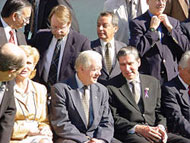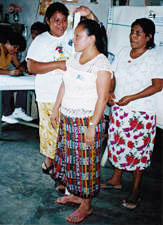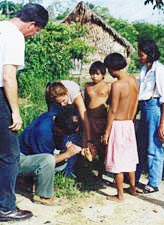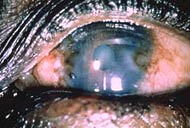During November 2001, former President Jimmy Carter attended the 11th annual InterAmerican Conference on Onchocerciasis in Mexico City, which brought together high-level representatives from the six onchocerciasis- or river blindness-endemic countries in the Americas to discuss recent findings that, under certain conditions, it is feasible to eliminate river blindness in the Americas. Occurring mostly in Africa, the disease also threatens about 540,000 people in Mexico, Guatemala, Venezuela, Colombia, Ecuador, and Brazil.
President Carter's report (excerpted from the Jan.-June 2002 Carter Center News) follows:
River blindness is caused by the bite of small black flies, not much bigger than Georgia gnats, that breed only in rapidly flowing streams with high oxygen content. As centuries have passed, people have abandoned rich bottomland near rivers and moved to less fertile hillside areas to avoid contact with the insects. It is estimated that people in affected areas are bitten more than 20,000 times each year, so everyone in an endemic village will harbor the disease.
For many years, river blindness could be prevented by only two methods: either to treat the stream with insecticides to kill the fly larvae or to administer a strong medicine with serious side effects. But some years ago, when it was discovered that ivermectin, a veterinary medicine used to prevent heartworms in animals, was also effective in its human formulation against river blindness, Merck & Co.'s chief executive officer, Dr. Roy Vagelos, came to Atlanta and offered their Mectizan® tablets free of charge, provided we could work out a procedure whereby the medicine could be safely distributed in remote areas.
Today, The Carter Center has helped to deliver 35 million treatments directly to individuals in endemic villages, and we are now maintaining an annual rate of seven million, of which about 600,000 treatments per year are in the Americas. Results vary even within countries. For instance, in Mexico there have been no new cases in Oaxaca since 1998, while the disease continues to spread in Chiapas, where political unrest has interfered with delivery of Mectizan. However, the overall effort has been very successful.
We have been the lead agency among the endemic countries in this hemisphere, and there are several other organizations that share this responsibility with us in Africa, where we are treating about 6.5 million people in five countries. Our partners in the Americas are International Lions Clubs, the Pan-American Health Organization, the InterAmerican Development Bank, the Centers for Disease Control, and national health departments. The work of the Center and its partners has helped reduce the number of people at risk in the Americas from 4.7 million in 1995 to an estimated 500,000 people today.




Please sign up below for important news about the work of The Carter Center and special event invitations.